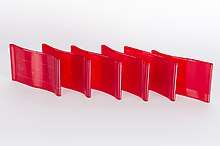Dictabelt
The Dictabelt,[1] in early years and much less commonly also called a Memobelt, is an analog audio recording medium commercially introduced by the American Dictaphone company in 1947. Having been intended for recording dictation and other speech for later transcription, it is a write-once-read-many medium consisting of a 5-mil (0.13 mm) thick transparent vinyl (according to a 1960s Dictaphone user manual: cellulose acetate butyrate) plastic belt 3.5 inches (89 mm) wide and 12 inches (300 mm) around.[2] The belt is loaded onto a pair of metal cylinders, put under tension, then rotated like a tank tread.[3] It is inscribed with an audio-signal-modulated helical groove by a stylus which is slowly moved across the rotating belt. Unlike the stylus of a record cutter, the Dictabelt stylus is blunt and in recording mode it simply impresses a groove into the plastic rather than engraving it and throwing off a thread of waste material.[4] The Dictabelt system was popular, and by 1952, made up 90% of Dictaphone's sales.[5]
 Several Dictabelts | |
| Media type | Grooved belt |
|---|---|
| Encoding | Analog groove modulation |
| Capacity | 15 minutes |
| Developed by | Dictaphone |
| Usage | Dictation, audio storage |
| Released | 1947 |
| Discontinued | c. 1980 |
Dictabelts were more convenient and provide better audio quality than the reusable wax cylinders they replaced. The belts can be folded for storage and will fit into an ordinary letter-size envelope. However, the plastic loses flexibility as it ages. If a belt is stored sharply folded for a long time, it will become permanently creased and unplayable without special treatment.[6] Dictabelts were red until 1964, blue from 1964 to 1975, then purple until they were discontinued around 1980. Each has a capacity of about 15 minutes at the standard speed. At least one Dictaphone model featured a half-speed, low-fidelity 30-minute option.
In the 1960s, Virginia required that all of its circuit courts be outfitted with Dictabelt machines.[7]
Along with a Gray Audograph sound recorder, a Dictabelt recorded the police department radio channels in Dallas, Texas, during the John F. Kennedy assassination. These recordings were reviewed by the United States House Select Committee on Assassinations.
References
- Morton, David (2000). Off the Record: The Technology and Culture of Sound Recording in America. Rutgers University Press. ISBN 0-8135-2747-3.
- Curator, Museum (2013-04-30). "Dictabelt (1947 – 1980) | Museum Of Obsolete Media". Obsoletemedia.org. Retrieved 2017-07-20.
- http://www.archeophone.org/dictabelt/windex.php
- http://www.poppyrecords.co.uk/ADM001/S09.htm
- Morton, David (2000). Off the Record: The Technology and Culture of Sound Recording in America. Rutgers University Press.
dictabelt.
- "Dictabelts". Poppyrecords.co.uk. Retrieved 2017-07-20.
- "about". Dictabelt Rerecord. Retrieved 2017-07-20.
External links
- Image - History of the Dictation Equipment Industry (archived)
- Funny, That Doesn’t Sound Like Me - Article with several images
- Vintage Tech: Dictaphone Dictabelt 800 Record Cutter, databits via YouTube, uploaded on 2 July 2016